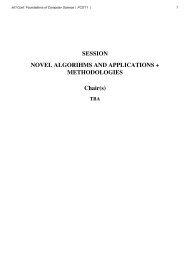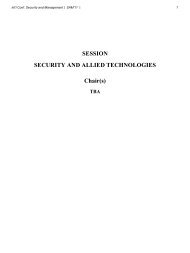Virtual processor frequency emulation - World-comp.org
Virtual processor frequency emulation - World-comp.org
Virtual processor frequency emulation - World-comp.org
You also want an ePaper? Increase the reach of your titles
YUMPU automatically turns print PDFs into web optimized ePapers that Google loves.
By the end of the algorithm, if the required <strong>frequency</strong> is not<br />
among the known <strong>frequency</strong> of the <strong>processor</strong>, it is immediately<br />
emulated.<br />
2) Processor <strong>frequency</strong> <strong>emulation</strong>: The <strong>emulation</strong> is based<br />
on the cumulative functions principle. It is convenient to<br />
describe data flows by means of the cumulative function<br />
f(t), defined as the number of elements seen on the flow<br />
in time interval [0, t]. By convention, we take f(0) = 0,<br />
unless otherwise specified. Function f is always wide-sense<br />
increasing, it means that f(s) ≤ f(t) for all s ≤ t.<br />
Suppose 2 wide-sense increasing functions f and g, the<br />
notation f + g denotes the point-wise sum of functions f and<br />
g.<br />
(f + g)(t) = f(t) + g(t) (2)<br />
Notation f ≤ (=, ≥) g means that f(t) ≤ (=, ≥) g(t) for<br />
all t [14].<br />
To exploit this notion, we defined 3 cumulative <strong>frequency</strong><br />
functions: CumF high (t), CumF low (t) and CumF host (t).<br />
Where CumF high (t), CumF low (t) and CumF host (t) represent<br />
the functions for the higher <strong>processor</strong> <strong>frequency</strong> , the<br />
lower and the required <strong>processor</strong> <strong>frequency</strong> respectively. In<br />
our case, we defined the cumulative <strong>frequency</strong> corresponding<br />
to a particular value as the sum of all the frequencies up<br />
to and including that value. Meaning that: CumF high (t) =<br />
∑ t<br />
k=0 f high.<br />
At each tick of the scheduler and for each <strong>frequency</strong><br />
involved (including the emulated <strong>frequency</strong>) in the <strong>emulation</strong><br />
of the <strong>frequency</strong>, we <strong>comp</strong>ute its cumulative <strong>frequency</strong><br />
(Listing 2). The <strong>comp</strong>utation of each cumulative <strong>frequency</strong> is<br />
executed as follow:<br />
• Initially, the cumulative frequencies functions are<br />
equal to zero (their initial value). This value is reinitialized<br />
when the current load need a different <strong>frequency</strong><br />
or when the current one is already emulated<br />
(line 17),<br />
• At each tick, the cumulative <strong>frequency</strong> of the emulated<br />
<strong>frequency</strong> (CumF host (t)) is incremented by its value:<br />
CumF host (t) + = f host (line 7 and line13),<br />
• At each tick, only one <strong>frequency</strong> is set (either f high<br />
or f low ). The choice of the <strong>frequency</strong> is carried out as<br />
follows:<br />
◦ The sum of CumF high (t) and CumF low is<br />
<strong>comp</strong>uted according to the equation 2 and the<br />
result is <strong>comp</strong>ared to CumF host (t) (line 3),<br />
◦ If the sum is lower than CumF host (t), then<br />
the <strong>processor</strong> <strong>frequency</strong> is set to f high during<br />
the next quantum (line 6),<br />
◦ Else, if the sum is higher than CumF host , the<br />
<strong>processor</strong> <strong>frequency</strong> is set to f low during the<br />
next quantum (line 12),<br />
◦ If both are equal, the desired <strong>frequency</strong> was<br />
emulated and the different cumulative frequencies<br />
are reinitialized (line 17).<br />
Through these iterations and these oscillations, we managed<br />
to emulate our desired <strong>frequency</strong>. It should be mentioned that,<br />
the emulated <strong>frequency</strong> and the neighboring frequencies are<br />
obtained with the algorithm presented in Listing 1.These later<br />
(table LFreq[]) are passed as a parameter to the algorithm<br />
below.<br />
For instance, if we consider our example of section II-B,<br />
the goal was to emulate a <strong>processor</strong> <strong>frequency</strong> of 1.9285 Ghz.<br />
The surrounding frequencies are 1.995 Ghz and 1.862 Ghz.<br />
The execution of the algorithm of Listing 2 is as follows<br />
(Table I ):<br />
Init. CumFH = CumFL = CumF = SumFreq = 0<br />
cpuid = 0 ; NumbFH = NumFL = 0<br />
LFreq[0]=1.9285; LFreq[1]=1.995; LFreq[2]=1.862<br />
Step 1 SetFreq(0, LFreq[1]); CumFL = 0<br />
CumFH = 1.995 ; CumF = 1.9285<br />
NumbFH = 1;NumFL = 0 ; SumFreq= 1.995<br />
Step 2<br />
Step 3<br />
SumFreq ¿ CumF ⇒ SetFreq(0, LFreq[2]);<br />
CumFL = 1.862 ; NumFL = 1; CumFH = 1.995<br />
CumF = 3.857 ; NumbFH = 1, SumFreq = 3.857<br />
SumFreq = CumF ⇒ Init<br />
NumFL = 1 and NumFH = 1<br />
TABLE I.<br />
ALGORITHM VALIDATION<br />
This execution validates the number of time needed to<br />
emulate 1.9285 Ghz as presented in section III-A.<br />
1 void EmulateFrequency(int LFreq[], int CumFH,int CumFL,<br />
int CumF,int cpuid) {<br />
2 int SumFreq;<br />
3 SumFreq = CumFH + CumFL;<br />
4<br />
5 if (SumFreq < CumF){<br />
6 SetFreq(cpuid,LFreq[1]);<br />
7 CumF += LFreq[0];<br />
8 CumFH += LFreq[1];<br />
9 }<br />
10 else{<br />
11 if (SumFreq > CumF){<br />
12 SetFreq(cpuid,LFreq[2]);<br />
13 CumF += LFreq[0];<br />
14 CumFL += LFreq[2];<br />
15 }<br />
16 else{<br />
17 CumF = CumFH = CumFL = 0;<br />
18 }<br />
19 }<br />
20 }<br />
Listing 2.<br />
Emulate <strong>processor</strong> <strong>frequency</strong><br />
During this execution, we remind that there is a trigger<br />
in charge of the <strong>comp</strong>utation of the absolute load and the<br />
notification of the current desired <strong>frequency</strong>. This situation<br />
also leads to a reinitialization of all the cumulative frequencies<br />
value.<br />
The next section presents some experiments to validate our<br />
proposal.<br />
IV.<br />
VERIFICATION OF OUR PROPOSAL<br />
We previously presented our approach and its implementation<br />
in the default Xen credit scheduler. In this section, we will<br />
present the experiment environment, the application scenario<br />
and some experiments to validate our proposition.









